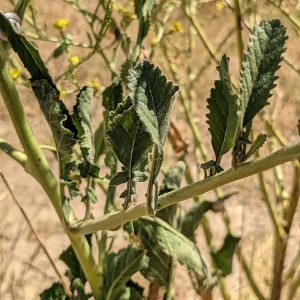Buchan Weed (Hirschfeldia incana), one of the many yellow-flowered Eurasian mustards that haunt this country’s roads, paddocks and landscapes and are often best differentiated at the seed pod.
In Australia, the history of this species begins with early 20th c. records near Melbourne and at localities in South Australia (Parsons and Cuthbertson indicated that there is a 1903 record from Bathurst NSW, however this has not been digitised). A likely contaminant of imported seed grain or hay, in 1911 the plant was collected on Melbourne’s future airport lands at Essendon, and in SA that same year on roadsides and fields around Port Lincoln on the Eyre Peninsula. In 1917 it was collected at Millicent in SA’s south-east.
Known generally as Hoary Mustard or Shortpod Mustard, how the plant earned its Australian idiom was a bit of an unacknowledged mystery. Despite later notions that it must have been common at Buchan in Victoria, there are no early newspaper reports referring to the weed as a problem on the Snowy and its tributaries. In fact, the first botanical record of the plant in East Gippsland was only made in 1937, and the name goes unused in period newspapers from Victoria. Parsons and Cuthbertson’s Noxious Weeds of Australia (2001), which guesses all too casually that ‘ “Buchan Weed” possibly refers to the early presence of the weed along the Buchan River’ is likely responsible for the now commonly repeated notion that the name refers to East Gippsland. Although established at Glasgow, we should note for completeness that the species is also not apparently a problem around the original Buchan Burn in Scotland’s SW.
When the 1925 update to Ewart’s Weeds, Poison Plants and Naturalised Aliens of Victoria acknowledged the species, ‘a weed of waste places, and if neglected… a troublesome weed in cultivated ground, and even in pastures,’ authors Audas and Morris crucially did not call it Buchan Weed but instead just Hoary Brassica.
Yet as early as 1919, South Australians were referring to Buchan’s Weed or Buchan Weed in newspapers at Millicent, Mount Gambier and Penola. Alongside the legendary Tantanoola Tiger, the Buchan moniker for our weed almost certainly originated in the south-east triangle formed by those SA towns. There is even a small drainage south-west of Tantanoola once or perhaps still known as Buchan’s Creek; while we haven’t yet dug further to find the exact link to that region’s infamous Buchan family of the 1860s-1870s, there presumably is one.
View Original Post on Instagram
Search for information about Hirschfeldia incana in the Flora of Victoria
View information and occurrences of Hirschfeldia incana on the Atlas of Living Australia










